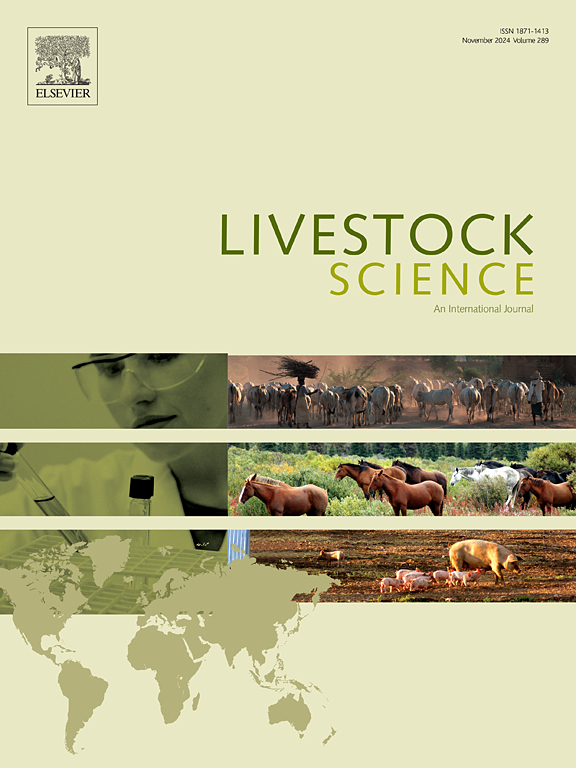在以仔猪体重过轻为主要标准的情况下,对大窝仔猪进行商业交叉寄养的影响
IF 1.8
3区 农林科学
Q2 AGRICULTURE, DAIRY & ANIMAL SCIENCE
引用次数: 0
摘要
在集约化养猪生产中,旨在减少损失的窝仔管理至关重要,而交叉育肥(CF)是一种常用的方法。交叉配种是一项重大挑战,尤其是在繁殖高产母猪时。因此,我们对猪场条件下非试验性交叉寄养的效率进行了调查。观察性研究共包括来自 25 窝连续产仔的 360 头仔猪(Choice Genetics - Naima 母猪 × P76 公猪)。其中 4 窝共 48 头仔猪为对照组,其余 21 窝共 51 头仔猪(CF 仔猪)按照猪场标准程序按体重混合饲养。这些仔猪被转移到一头特定的寄养母猪上,将 2 至 10 头不同窝的仔猪混合在一起。CF仔猪比寄养母猪和对照组仔猪体重轻。死亡仔猪的体重低于存活仔猪,尤其是 CF 组(≈35%)。半数 CF 仔猪在出生几天后死亡,而居民组和对照组的死亡率分别为 13% 和 8%,这导致 CF 仔猪的死亡率(19%)比对照组更高。异常高的死亡率主要与两胎以上的 CF 幼仔有关。因此,从生产和福利的角度来看,将多胎仔猪合群并将仔猪出生体重低作为 CF 的主要标准似乎并不合理,甚至可能产生相反的效果,增加死亡率。为降低死亡率,可测试其他策略(如移动重型仔猪)和/或考虑其他 CF 标准(如乳头顺序、窝产仔数、奇偶数)。本文章由计算机程序翻译,如有差异,请以英文原文为准。
Implications of commercial cross-fostering in large litters when low body weight of piglets is the main criterion
Litter management aimed at reducing losses is crucial in intensive pig production, with cross-fostering (CF) being a commonly used approach. CF is a major challenge, especially in the breeding of highly prolific sows. We therefore investigated the efficiency of non-experimental CF under farm conditions. A total of 360 piglets (Choice Genetics − Naima sows × P76 boars) from 25 sequential litters were included in the observational study. Four litters with 48 piglets represented the control group and in the remaining 21 litters, 51 piglets (CF piglets) were cross-fostered according to the farm's standard procedure of mixing litters by body weight. The piglets were transferred to a specific foster sow in a way that piglets from 2 to 10 different litters were mixed. The CF piglets were lighter than the residents and the control piglets. The piglets that died had lower body weight than the survivors, especially in the CF group (≈35 %). Half of the CF piglets died a few days after birth, while mortality was 13 % in the residents and 8 % in the control group, resulting in a tendency of higher mortality in CF litters (19 %) compared to the control group. The unusually high mortality was mainly related to CF litters with more than two litters combined. Therefore, combining multiple litters and the use of low piglet birth weight as the main CF criterion does not seem to be justified from both a production and welfare point of view and could even have the opposite effect and increase mortality. To reduce mortality, other strategies could be tested (e.g. moving heavy piglets) and/or other CF criteria considered (e.g. teat order, litter size, parity).
求助全文
通过发布文献求助,成功后即可免费获取论文全文。
去求助
来源期刊

Livestock Science
农林科学-奶制品与动物科学
CiteScore
4.30
自引率
5.60%
发文量
237
审稿时长
3 months
期刊介绍:
Livestock Science promotes the sound development of the livestock sector by publishing original, peer-reviewed research and review articles covering all aspects of this broad field. The journal welcomes submissions on the avant-garde areas of animal genetics, breeding, growth, reproduction, nutrition, physiology, and behaviour in addition to genetic resources, welfare, ethics, health, management and production systems. The high-quality content of this journal reflects the truly international nature of this broad area of research.
 求助内容:
求助内容: 应助结果提醒方式:
应助结果提醒方式:


